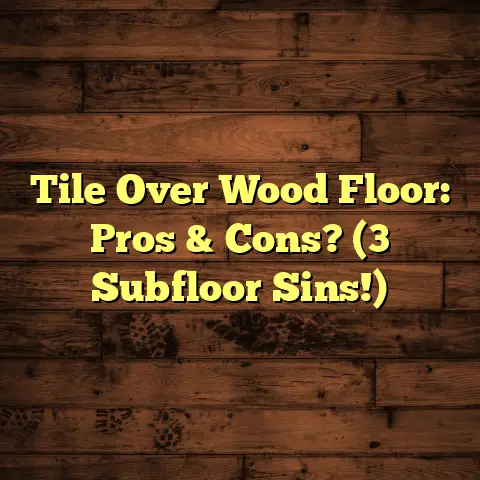Bamboo Floor Care: Best Tips? (3 Cleaning Blunders!)
As a flooring contractor for over 15 years, I’ve seen trends come and go, but bamboo has really stuck around. Why?
Because it’s not just beautiful; it’s also a fantastic eco-friendly option.
More and more people are choosing bamboo, and for good reason. It’s sustainable, looks great, and adds a touch of natural elegance to any home.
But here’s the thing: even the toughest bamboo floor needs the right TLC.
Without proper care, you might not get the longevity and beauty you’re hoping for.
That’s why I’m here to spill the beans on how to keep your bamboo floors looking their best for years to come.
We’ll dive into the best care tips and, more importantly, the cleaning blunders you absolutely need to avoid.
Let’s get started!
Section 1: Understanding Bamboo Flooring
What is Bamboo Flooring?
Okay, let’s get down to basics. Bamboo isn’t actually wood; it’s a grass! I know, mind-blowing, right?
But don’t let that fool you. It’s incredibly strong and durable when processed correctly.
The process involves harvesting the bamboo stalks, slicing them into strips, and then bonding them together under high pressure.
This creates a solid, stable material perfect for flooring.
Now, there are a few different types of bamboo flooring you should know about:
- Solid Bamboo: This is made from solid strips of bamboo. It’s durable and can be refinished, similar to hardwood.
- Engineered Bamboo: This type has a bamboo veneer on top of a plywood or fiberboard core. It’s more resistant to moisture and great for basements.
- Strand-Woven Bamboo: This is the toughest of the bunch! The bamboo strands are shredded and compressed, making it incredibly dense and durable.
Each type has its own pros and cons, so it’s worth doing your research to see which one fits your needs best.
Why Choose Bamboo?
Alright, let’s talk about why bamboo is such a hot commodity.
The biggest reason, in my opinion, is its environmental friendliness.
Bamboo is one of the fastest-growing plants on Earth. It can be harvested in as little as 3-5 years, compared to decades for hardwood trees.
This rapid growth makes it a highly renewable resource.
Plus, bamboo forests absorb a significant amount of carbon dioxide, helping to reduce your carbon footprint.
According to a study by the Bamboo Flooring Association, bamboo flooring has a significantly lower carbon footprint compared to traditional hardwood flooring.
That’s a win for your home and the planet!
But sustainability isn’t the only reason to choose bamboo.
It’s also surprisingly durable, especially strand-woven varieties.
It’s naturally resistant to moisture, making it suitable for kitchens and bathrooms (with proper care, of course!).
And it can handle a wide range of climates, making it a versatile choice for homeowners everywhere.
Section 2: Essential Care Tips for Bamboo Floors
Okay, now that we’ve covered the basics, let’s get into the nitty-gritty of caring for your bamboo floors.
Trust me, a little effort goes a long way in keeping them looking fantastic.
Tip 1: Regular Cleaning Routine
Think of your bamboo floors like your skin: they need regular cleaning to stay healthy and radiant.
Here’s my recommended cleaning schedule:
- Daily: A quick sweep with a soft broom or dust mop to remove loose dirt and debris.
- Weekly: A damp mop with a pH-neutral cleaner. This will remove any build-up and keep your floors sparkling.
- Monthly: A more thorough cleaning, focusing on high-traffic areas and any stubborn spots.
For daily cleaning, I swear by microfiber mops.
They’re super effective at picking up dust and dirt without scratching the surface.
As for cleaning products, always go for pH-neutral cleaners specifically designed for bamboo or hardwood floors.
Avoid anything too harsh or abrasive, as these can damage the finish.
Here’s a step-by-step guide for deep cleaning:
- Sweep or vacuum: Remove all loose dirt and debris.
- Prepare your cleaning solution: Mix your pH-neutral cleaner with water according to the manufacturer’s instructions.
- Damp mop: Dip your mop into the solution, wring it out thoroughly, and mop the floor in sections.
- Dry the floor: Use a clean, dry microfiber cloth to remove any excess moisture.
Tip 2: Protecting from Scratches and Dents
Okay, let’s talk about protecting your floors from the everyday wear and tear of life.
One of the easiest ways to prevent scratches and dents is to use furniture pads.
Stick them under the legs of all your furniture, especially chairs and tables that get moved around a lot.
Area rugs are also your best friend.
Place them in high-traffic areas like hallways and living rooms to protect the flooring underneath.
When rearranging furniture, never drag it across the floor.
Always lift and carry it to avoid scratches.
And if you’re moving heavy items, use furniture sliders to distribute the weight and prevent dents.
Tip 3: Managing Humidity Levels
Bamboo is a natural material, which means it’s susceptible to changes in humidity and temperature.
Too much moisture can cause it to swell, while too little can cause it to shrink and crack.
Ideally, you want to maintain a consistent indoor climate with a humidity level between 30-50%.
Use a hygrometer to monitor the humidity in your home.
If it’s too high, use a dehumidifier to remove excess moisture from the air.
If it’s too low, use a humidifier to add moisture.
During the winter months, when the air tends to be drier, I always recommend using a humidifier to protect your bamboo floors.
Section 3: The 3 Common Cleaning Blunders to Avoid
Alright, now for the part you’ve been waiting for: the cleaning blunders that can wreak havoc on your bamboo floors.
Trust me, I’ve seen it all, and I’m here to help you avoid these common mistakes.
Blunder 1: Using Harsh Chemicals
This is a big one. I can’t stress enough how important it is to avoid harsh chemicals on your bamboo floors.
Bleach, ammonia, and abrasive cleaners can strip the finish, dull the surface, and even damage the bamboo itself.
I’ve seen floors ruined by well-meaning homeowners who thought they were doing a good job cleaning.
Instead of harsh chemicals, opt for safe, alternative cleaning solutions.
As I mentioned before, pH-neutral cleaners are your best bet.
You can also make your own gentle cleaning solution by mixing a few drops of dish soap with warm water.
Just be sure to test it in an inconspicuous area first to make sure it doesn’t damage the finish.
Blunder 2: Excessive Water Usage
Water is the enemy of bamboo floors. Too much water can seep into the seams, causing the bamboo to warp, swell, and even rot.
I’ve seen floors buckle and lift due to excessive water damage.
When damp mopping, always wring out your mop thoroughly.
It should be damp, not soaking wet.
Avoid pouring water directly onto the floor.
Instead, spray the cleaning solution onto your mop or cloth.
And after mopping, always dry the floor with a clean, dry microfiber cloth to remove any excess moisture.
Blunder 3: Neglecting Immediate Spills
Spills happen, it’s a fact of life. But how you handle them can make all the difference.
Neglecting spills can lead to staining and moisture damage.
The longer a spill sits, the more likely it is to penetrate the finish and damage the bamboo.
As soon as a spill occurs, blot it up immediately with a clean, dry cloth.
Avoid rubbing, as this can spread the spill and make it worse.
For sticky spills, use a damp cloth to gently wipe away the residue.
For tough stains, you can try using a specialized stain remover designed for bamboo or hardwood floors.
Always test it in an inconspicuous area first to make sure it doesn’t damage the finish.
Here’s a quick guide on how to clean different types of spills:
- Liquids: Blot up immediately with a clean, dry cloth.
- Food: Scrape away any solid pieces, then wipe with a damp cloth.
- Pet accidents: Clean up immediately with a pet-specific cleaner to remove odors and prevent staining.
Section 4: Long-term Maintenance Strategies
Okay, you’ve got the daily and weekly care down. Now let’s talk about long-term maintenance to keep your bamboo floors looking their best for years to come.
Routine Inspections
Regular inspections are key to catching problems early and preventing them from becoming bigger, more expensive issues.
I recommend inspecting your bamboo floors at least once a month.
Look for signs of wear, damage, or moisture problems.
Pay close attention to high-traffic areas, seams, and areas around doorways and windows.
If you notice any cracks, scratches, or dents, address them as soon as possible.
Small scratches can often be buffed out with a scratch repair kit.
Larger cracks or dents may require professional repair.
If you notice any signs of moisture damage, such as warping or discoloration, investigate the source of the moisture and address it immediately.
Re-finishing and Restoration
Even with the best care, bamboo floors will eventually show signs of wear and tear.
When this happens, re-finishing can restore their original beauty.
Re-finishing involves sanding down the old finish, repairing any damage, and applying a new finish.
The frequency of re-finishing depends on the amount of traffic your floors receive and the type of finish used.
Generally, you can expect to re-finish your bamboo floors every 7-10 years.
The process of sanding, staining, and sealing bamboo flooring is similar to that of hardwood flooring.
However, it’s important to use the right products and techniques to avoid damaging the bamboo.
I always recommend hiring a professional flooring contractor to re-finish your bamboo floors.
They have the experience and expertise to do the job right and ensure a beautiful, long-lasting finish.
Conclusion
So, there you have it: my ultimate guide to bamboo floor care!
We’ve covered everything from the basics of bamboo flooring to the essential care tips and the common cleaning blunders to avoid.
I hope you found this information helpful and that you’re now feeling confident in your ability to care for your bamboo floors.
Remember, proper care and maintenance are essential for preserving the beauty and sustainability of your bamboo floors.
By avoiding these cleaning blunders and following my best care tips, you can enjoy the beauty and sustainability of bamboo floors for years to come.
Thanks for reading, and happy flooring!





